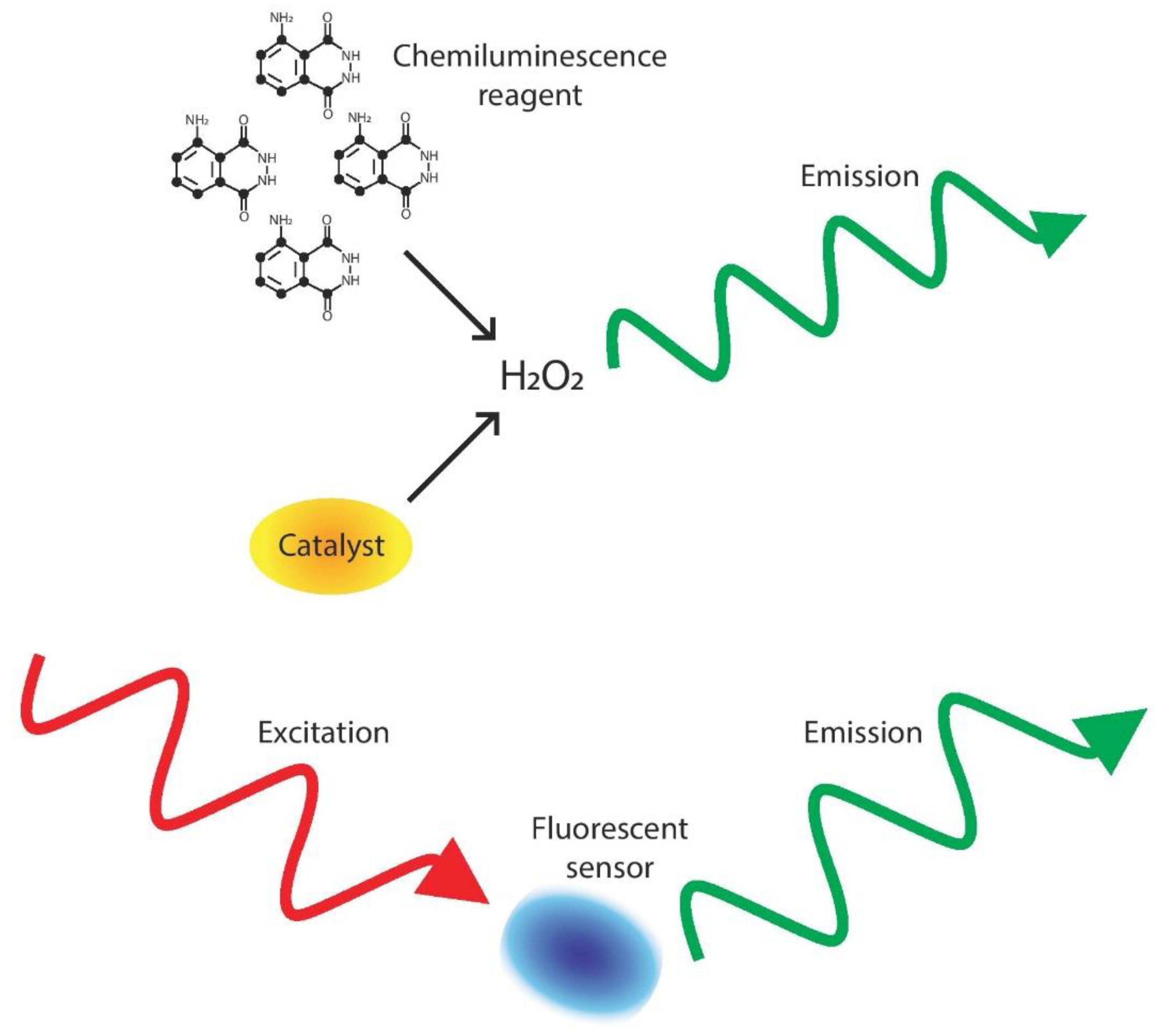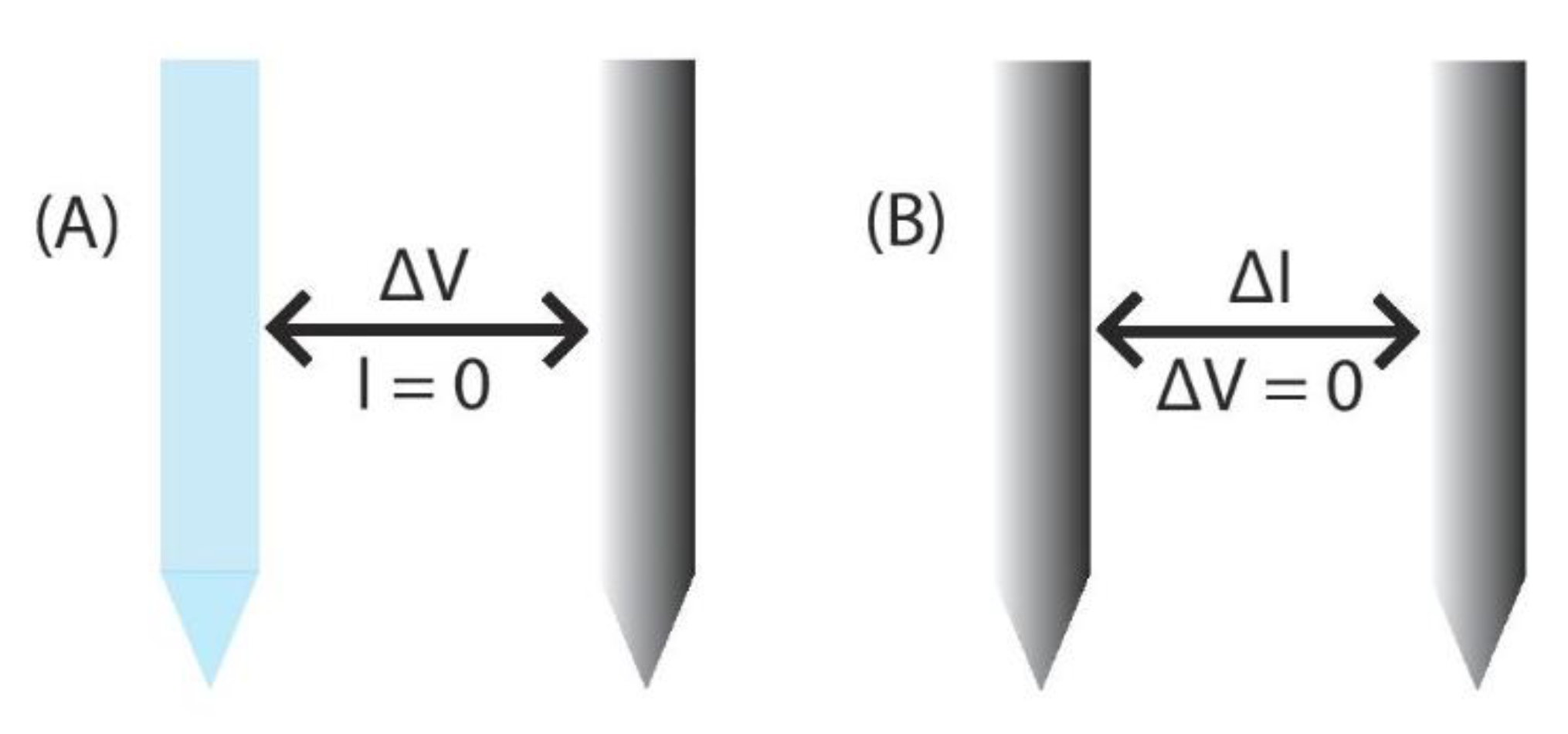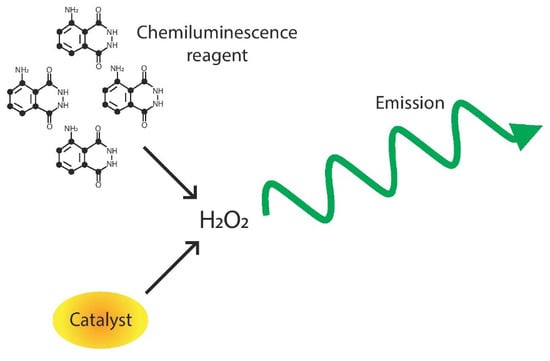Hydrogen Peroxide Sensors for Biomedical Applications
Abstract
1. Introduction
2. Light Detecting Sensors
2.1. Chemiluminescence
2.1.1. Developments Prior to 2015
2.1.2. Developments from 2015 to 2019
2.2. Fluorescence
2.2.1. Developments Prior to 2015
2.2.2. Developments from 2015 to 2019
3. Electrochemical Probes
3.1. Potentiometric
3.1.1. Developments Prior to 2015
3.1.2. Developments from 2015 to 2019
3.2. Amperometric
3.2.1. Developments Prior to 2015
3.2.2. Developments from 2015 to 2019
Enzyme-Free Sensors
4. Sensor Specifics
5. Conclusions
Author Contributions
Funding
Conflicts of Interest
References
- Wang, X.; Martindale, J.L.; Liu, Y.; Holbrook, N.J. The cellular response to oxidative stress: Influences of mitogen-activated protein kinase signalling pathways on cell survival. Biochem. J. 1998, 333, 291. [Google Scholar] [CrossRef] [PubMed]
- Schreck, R.; Rieber, P.; Baeuerle, P.A. Reactive oxygen intermediates as apparently widely used messengers in the activation of the NF-kappa B transcription factor and HIV-1. EMBO J. 1991, 10, 2247–2258. [Google Scholar] [CrossRef]
- Abe, J.; Berk, B. Fyn and JAK2 mediate ras activation by reactive oxygen species. J. Biol. Chem. 1999, 274, 21003–21010. [Google Scholar] [CrossRef] [PubMed]
- Elias, H.; Vayssié, S. Reactive peroxo compounds generated in situ from hydrogen peroxide: Kinetics and catalytic application in oxidation processes. Peroxide Chem. 2000, 128–138. [Google Scholar] [CrossRef]
- Imlay, J.A.; Linn, S. Mutagenesis and stress responses induced in Escherichia coli by hydrogen peroxide. J. Bacteriol. 1987, 169, 2967. [Google Scholar] [CrossRef]
- Mittal, M.; Siddiqui, M.R.; Tran, K.; Reddy, S.P.; Malik, A.B. Reactive oxygen species in inflammation and tissue injury. Antioxid. Redox Signal. 2013, 20, 1126–1167. [Google Scholar] [CrossRef]
- Sen, S.; Chakraborty, R.; Sridhar, C.; Reddy, Y.S.R.; De, B. Free radicals, antioxidants, Diseases and phytomedicines: Current status and Future prospect. Int. J. Pharm. Sci. Rev. Res. 2010, 3, 91–100. [Google Scholar]
- Klassen, N.V.; Marchington, D.; McGowan, H.C.E. H2O2 Determination by the I3-Method and by KMnO4 Titration. Anal. Chem. 1994, 66, 2921–2925. [Google Scholar] [CrossRef]
- Gimeno, P.; Bousquet, C.; Lassu, N.; Maggio, A.-F.; Civade, C.; Brenier, C.; Lempereur, L. High-performance liquid chromatography method for the determination of hydrogen peroxide present or released in teeth bleaching kits and hair cosmetic products. J. Pharm. Biomed. Anal. 2015, 107, 386–393. [Google Scholar] [CrossRef]
- Igarashi, S.; Hinze, W.L. Enzymatic assay with detection by enhanced luminol chemiluminescence in a reversed micellar system: Determination of l-amino acids and glucose. Anal. Chim. Acta 1989, 225, 147–157. [Google Scholar] [CrossRef]
- Kim, J.-H.; Patra, C.R.; Arkalgud, J.R.; Boghossian, A.A.; Zhang, J.; Han, J.-H.; Reuel, N.F.; Ahn, J.-H.; Mukhopadhyay, D.; Strano, M.S. Single-molecule detection of H2O2 mediating angiogenic redox signaling on fluorescent single-walled carbon nanotube array. ACS Nano 2011, 5, 7848–7857. [Google Scholar] [CrossRef] [PubMed]
- Wang, X.; Qin, W. Reactive intermediates-induced potential responses of a polymeric membrane electrode for ultrasensitive potentiometric biosensing. Chem. Commun. 2012, 48, 4073–4075. [Google Scholar] [CrossRef] [PubMed]
- Ujjain, S.K.; Das, A.; Srivastava, G.; Ahuja, P.; Roy, M.; Arya, A.; Bhargava, K.; Sethy, N.; Singh, S.K.; Sharma, R.K.; et al. Nanoceria based electrochemical sensor for hydrogen peroxide detection. Biointerphases 2014, 9, 031011. [Google Scholar] [CrossRef] [PubMed]
- Ettre, L.S.; Zlatkis, A. 75 Years of Chromatography: A Historical Dialogue; Elsevier: Amsterdam, The Netherlands, 1979. [Google Scholar]
- Vogel, A.I.; Mendham, J. Vogel’s Textbook of Quantitative Chemical Analysis; Prentice Hall: Upper Saddle River, NJ, USA, 2000. [Google Scholar]
- Andreotti, P.E. Chemiluminescence: Principles and Applications in Biology and Medicine. J. Pharm. Sci. 1989, 78, 787. [Google Scholar] [CrossRef]
- Guilbault, G.G. Practical Fluorescence: Theory, Methods and Techniques; M. Dekker: New York, NY, USA, 1973. [Google Scholar]
- Galus, Z. Fundamentals of Electrochemical Analysis; Ellis Horwood: Chichester, UK; Halsted Press, a division of Wiley: New York, NY, USA, 1976. [Google Scholar]
- Lingane, J.J. Electroanalytical Chemistry; Interscience Publishers: New York, NY, USA, 1958. [Google Scholar]
- Pundir, C.S.; Deswal, R.; Narwal, V. Quantitative analysis of hydrogen peroxide with special emphasis on biosensors. Bioprocess Biosyst. Eng. 2018, 41, 313–329. [Google Scholar] [CrossRef] [PubMed]
- Yunus, S.; Attout, A.; Vanlancker, G.; Bertrand, P.; Ruth, N.; Galleni, M. A method to probe electrochemically active material state in portable sensor applications. Sens. Actuators B Chem. 2011, 156, 35–42. [Google Scholar] [CrossRef]
- Hopkins, J.; Fidanovski, K.; Lauto, A.; Mawad, D. All-organic semiconductors for electrochemical biosensors: An overview of recent progress in material design. Front. Bioeng. Biotechnol. 2019, 7, 237. [Google Scholar] [CrossRef]
- Yunus, S.; Jonas, A.M.; Lakard, B. Potentiometric biosensors. In Encyclopedia of Biophysics; Roberts, G.C.K., Ed.; Springer: Berlin, Germany, 2013; pp. 1941–1946. [Google Scholar]
- Villagrasa, J.P.; Colomer-Farrarons, J.; Miribel, P.L. Bioelectronics for amperometric biosensors. In State of the Art in Biosensors-General Aspects; IntechOpen: London, UK, 2013. [Google Scholar]
- Lee, D.; Khaja, S.; Velasquez-Castano, J.C.; Dasari, M.; Sun, C.; Petros, J.; Taylor, W.R.; Murthy, N. In vivo imaging of hydrogen peroxide with chemiluminescent nanoparticles. Nat. Mater. 2007, 6, 765–769. [Google Scholar] [CrossRef]
- Xiao, H.; Li, P.; Hu, X.; Shi, X.; Zhang, W.; Tang, B. Simultaneous fluorescence imaging of hydrogen peroxide in mitochondria and endoplasmic reticulum during apoptosis. Chem. Sci. 2016, 7, 6153–6159. [Google Scholar] [CrossRef]
- Xu, J.; Zhang, Y.; Yu, H.; Gao, X.; Shao, S. Mitochondria-targeted fluorescent probe for imaging hydrogen peroxide in living cells. Anal. Chem. 2016, 88, 1455–1461. [Google Scholar] [CrossRef]
- J.O’Brien, P.; Bechara, E.J.H.; R.O’Brien, C.; Duran, N.; Cilento, G. Generation of bio-electronic energy by electron transfer: Reduction of peroxidase compound I and compound II by eosine. Biochem. Biophys. Res. Commun. 1978, 81, 75–81. [Google Scholar] [CrossRef]
- De Toledo, S.M.; Haun, M.; Bechara, E.J.H.; Durán, N. Peroxidase and hydrogen peroxide detection by a bioenergized method. Anal. Biochem. 1980, 105, 36–38. [Google Scholar] [CrossRef]
- Wu, W.; Li, J.; Chen, L.; Ma, Z.; Zhang, W.; Liu, Z.; Cheng, Y.; Du, L.; Li, M. Bioluminescent probe for hydrogen peroxide imaging in vitro and in vivo. Anal. Chem. 2014, 86, 9800–9806. [Google Scholar] [CrossRef] [PubMed]
- Yu, D.; Wang, P.; Zhao, Y.; Fan, A. Iodophenol blue-enhanced luminol chemiluminescence and its application to hydrogen peroxide and glucose detection. Talanta 2016, 146, 655–661. [Google Scholar] [CrossRef]
- He, R.; Tang, H.; Jiang, D.; Chen, H.-Y. electrochemical visualization of intracellular hydrogen peroxide at single cells. Anal. Chem. 2016, 88, 2006–2009. [Google Scholar] [CrossRef]
- Koren, K.; Jensen, P.Ø.; Kühl, M. Development of a rechargeable optical hydrogen peroxide sensor–sensor design and biological application. Analyst 2016, 141, 4332–4339. [Google Scholar] [CrossRef]
- Sheng, Y.; Yang, H.; Wang, Y.; Han, L.; Zhao, Y.; Fan, A. Silver nanoclusters-catalyzed luminol chemiluminescence for hydrogen peroxide and uric acid detection. Talanta 2017, 166, 268–274. [Google Scholar] [CrossRef]
- Moßhammer, M.; Schrameyer, V.; Jensen, P.Ø.; Koren, K.; Kühl, M. Extracellular hydrogen peroxide measurements using a flow injection system in combination with microdialysis probes–Potential and challenges. Free Radic. Biol. Med. 2018, 128, 111–123. [Google Scholar] [CrossRef]
- Wang, Z.; Dong, B.; Feng, G.; Shan, H.; Huan, Y.; Fei, Q. Water soluble Hemin-mPEG-enhanced luminol chemiluminescence for sensitive detection of hydrogen peroxide and glucose. Anal. Sci. 2019, 19P150. [Google Scholar] [CrossRef]
- Jiao, L.; Xu, W.; Yan, H.; Wu, Y.; Liu, C.; Du, D.; Lin, Y.; Zhu, C. Fe–N–C single-atom nanozymes for the intracellular hydrogen peroxide detection. Anal. Chem. 2019, 91, 11994–11999. [Google Scholar] [CrossRef]
- King, D.W.; Cooper, W.J.; Rusak, S.A.; Peake, B.M.; Kiddle, J.J.; O’Sullivan, D.W.; Melamed, M.L.; Morgan, C.R.; Theberge, S.M. Flow injection analysis of H2O2 in natural waters using acridinium ester chemiluminescence: Method development and optimization using a kinetic model. Anal. Chem. 2007, 79, 4169–4176. [Google Scholar] [CrossRef] [PubMed]
- Sun, P.; Laforge, F.O.; Abeyweera, T.P.; Rotenberg, S.A.; Carpino, J.; Mirkin, M.V. Nanoelectrochemistry of mammalian cells. Proc. Natl. Acad. Sci. USA 2008, 105, 443. [Google Scholar] [CrossRef] [PubMed]
- Wang, Y.; Noël, J.-M.; Velmurugan, J.; Nogala, W.; Mirkin, M.V.; Lu, C.; Guille Collignon, M.; Lemaître, F.; Amatore, C. Nanoelectrodes for determination of reactive oxygen and nitrogen species inside murine macrophages. Proc. Natl. Acad. Sci. USA 2012, 109, 11534. [Google Scholar] [CrossRef]
- Yildirim, S.; Nursal, T.Z.; Tarim, A.; Torer, N.; Noyan, T.; Demiroglu, Y.Z.; Moray, G.; Haberal, M. Bacteriological profile and antibiotic resistance: Comparison of findings in a burn intensive care unit, other intensive care units, and the hospital services unit of a single center. J. Burn Care Res. 2005, 26, 488–492. [Google Scholar] [CrossRef] [PubMed]
- Hauser, A.R.; Rello, J. Severe Infections Caused by Pseudomonas aeruginosa; Springer: Berlin, Germany, 2012; Volume 7. [Google Scholar]
- Deng, M.; Xu, S.; Chen, F. Enhanced chemiluminescence of the luminol-hydrogen peroxide system by BSA-stabilized Au nanoclusters as a peroxidase mimic and its application. Anal. Methods 2014, 6, 3117–3123. [Google Scholar] [CrossRef]
- Xie, J.X.; Chen, W.J.; Wu, X.X.; Wu, Y.Y.; Lin, H. Enhanced luminol chemiluminescence by Co–Fe LDH nanoplates and its application in H2O2 and glucose detection. Anal. Methods 2017, 9, 974–979. [Google Scholar] [CrossRef]
- Chaichi, M.J.; Ehsani, M. Determination of glucose and cholesterol using a novel optimized luminol-CuO nanoparticles-H2O2 chemiluminescence method by box–behnken design. J. Fluoresc. 2015, 25, 861–870. [Google Scholar] [CrossRef]
- Xu, K.; Tang, B.; Huang, H.; Yang, G.; Chen, Z.; Li, P.; An, L. Strong red fluorescent probes suitable for detecting hydrogen peroxide generated by mice peritoneal macrophages. Chem. Commun. 2005, 5974–5976. [Google Scholar] [CrossRef]
- Paździoch-Czochra, M.; Wideńska, A. Spectrofluorimetric determination of hydrogen peroxide scavenging activity. Anal. Chim. Acta 2002, 452, 177–184. [Google Scholar] [CrossRef]
- Paital, B. A modified fluorimetric method for determination of hydrogen peroxide using homovanillic acid oxidation principle. BioMed Res. Int. 2014, 2014, 8. [Google Scholar] [CrossRef]
- Miller, E.W.; Albers, A.E.; Pralle, A.; Isacoff, E.Y.; Chang, C.J. Boronate-based fluorescent probes for imaging cellular hydrogen peroxide. J. Am. Chem. Soc. 2005, 127, 16652–16659. [Google Scholar] [CrossRef] [PubMed]
- Chang, M.C.Y.; Pralle, A.; Isacoff, E.Y.; Chang, C.J. A selective, cell-permeable optical probe for hydrogen peroxide in living cells. J. Am. Chem. Soc. 2004, 126, 15392–15393. [Google Scholar] [CrossRef] [PubMed]
- Belousov, V.V.; Fradkov, A.F.; Lukyanov, K.A.; Staroverov, D.B.; Shakhbazov, K.S.; Terskikh, A.V.; Lukyanov, S. Genetically encoded fluorescent indicator for intracellular hydrogen peroxide. Nat. Methods 2006, 3, 281–286. [Google Scholar] [CrossRef] [PubMed]
- Qian, P.; Qin, Y.; Lyu, Y.; Li, Y.; Wang, L.; Wang, S.; Liu, Y. A hierarchical cobalt/carbon nanotube hybrid nanocomplex-based ratiometric fluorescent nanosensor for ultrasensitive detection of hydrogen peroxide and glucose in human serum. Anal. Bioanal. Chem. 2019, 411, 1517–1524. [Google Scholar] [CrossRef]
- Onoda, M.; Uchiyama, T.; Mawatari, K.-I.; Kaneko, K.; Nakagomi, K. Simple and rapid determination of hydrogen peroxide using phosphine-based fluorescent reagents with sodium tungstate dihydrate. Anal. Sci. 2006, 22, 815–817. [Google Scholar] [CrossRef] [PubMed]
- Lu, H.; Xu, S. Visualizing BPA by molecularly imprinted ratiometric fluorescence sensor based on dual emission nanoparticles. Biosens. Bioelectron. 2017, 92, 147–153. [Google Scholar] [CrossRef] [PubMed]
- Gong, Y.; Chen, X.; Lu, Y.; Yang, W. Self-assembled dipeptide–gold nanoparticle hybrid spheres for highly sensitive amperometric hydrogen peroxide biosensors. Biosens. Bioelectron. 2015, 66, 392–398. [Google Scholar] [CrossRef]
- Ponmozhi, J.; Frias, C.; Marques, T.; Frazão, O. Smart sensors/actuators for biomedical applications: Review. Measurement 2012, 45, 1675–1688. [Google Scholar] [CrossRef]
- Parrilla, M.; Cánovas, R.; Andrade, F.J. Enhanced potentiometric detection of hydrogen peroxide using a platinum electrode coated with nafion. Electroanalysis 2017, 29, 223–230. [Google Scholar] [CrossRef]
- Cánovas, R.; Parrilla, M.; Blondeau, P.; Andrade, F.J. A novel wireless paper-based potentiometric platform for monitoring glucose in blood. Lab Chip 2017, 17, 2500–2507. [Google Scholar] [CrossRef]
- Mizutani, S.; Okumura, Y.; Horio, T.; Iwata, T.; Okumura, K.; Takahashi, K.; Murakami, Y.; Dasai, F.; Ishida, M.; Sawada, K. Development of glutamate sensor for neurotransmitter imaging. Sens. Mater. 2017, 29, 253–260. [Google Scholar]
- Iwata, T.; Mizutani, S.; Okumura, K.; Okumura, Y.; Takahashi, K.; Sawada, K. H2O2 Detection by redox-based potentiometric sensors under biological environments. Sens. Mater. 2018, 30, 2359–2367. [Google Scholar] [CrossRef]
- Zhang, Y.; Bai, X.; Wang, X.; Shiu, K.-K.; Zhu, Y.; Jiang, H. Highly sensitive graphene–pt nanocomposites amperometric biosensor and its application in living cell H2O2 detection. Anal. Chem. 2014, 86, 9459–9465. [Google Scholar] [CrossRef] [PubMed]
- Guler, M.; Turkoglu, V.; Kivanc, M.R. A novel enzymatic glucose biosensor and nonenzymatic hydrogen peroxide sensor based on (3-Aminopropyl) triethoxysilane functionalized reduced graphene oxide. Electroanalysis 2017, 29, 2507–2515. [Google Scholar] [CrossRef]
- Xu, X.X.; Zhang, J.X.; Guo, F.; Zheng, W.; Zhou, H.M.; Wang, B.L.; Zheng, Y.F.; Wang, Y.B.; Cheng, Y.; Lou, X.; et al. A novel amperometric hydrogen peroxide biosensor based on immobilized Hb in Pluronic P123-nanographene platelets composite. Colloids Surf. B Biointerfaces 2011, 84, 427–432. [Google Scholar] [CrossRef] [PubMed]
- Mu, Y.; Jia, D.; He, Y.; Miao, Y.; Wu, H.-L. Nano nickel oxide modified non-enzymatic glucose sensors with enhanced sensitivity through an electrochemical process strategy at high potential. Biosens. Bioelectron. 2011, 26, 2948–2952. [Google Scholar] [CrossRef] [PubMed]
- Thenmozhi, K.; Narayanan, S.S. Horseradish peroxidase and toluidine blue covalently immobilized leak-free sol-gel composite biosensor for hydrogen peroxide. Mater. Sci. Eng. C 2017, 70, 223–230. [Google Scholar] [CrossRef]
- Sekar, N.C.; Ge, L.; Mousavi Shaegh, S.A.; Ng, S.H.; Tan, S.N. A mediated turnip tissue paper-based amperometric hydrogen peroxide biosensor. Sens. Actuators B Chem. 2015, 210, 336–342. [Google Scholar] [CrossRef]
- Dramińska, S.; Bilewicz, R. Bienzymatic mediatorless sensing of total hydrogen peroxide with catalase and multi-copper enzyme co-adsorbed at carbon nanotube-modified electrodes. Sens. Actuators B Chem. 2017, 248, 493–499. [Google Scholar] [CrossRef]
- Gibson, T.D. Biosensors: The stabilité problem. Analusis 1999, 27, 630–638. [Google Scholar] [CrossRef]
- Oungpipat, W.; Alexander, P.W.; Southwell-Keely, P. A reagentless amperometric biosensor for hydrogen peroxide determination based on asparagus tissue and ferrocene mediation. Anal. Chim. Acta 1995, 309, 35–45. [Google Scholar] [CrossRef]
- Campàs, M.; Carpentier, R.; Rouillon, R. Plant tissue-and photosynthesis-based biosensors. Biotechnol. Adv. 2008, 26, 370–378. [Google Scholar] [CrossRef] [PubMed]
- Bai, Z.; Li, G.; Liang, J.; Su, J.; Zhang, Y.; Chen, H.; Huang, Y.; Sui, W.; Zhao, Y. Non-enzymatic electrochemical biosensor based on Pt NPs/RGO-CS-Fc nano-hybrids for the detection of hydrogen peroxide in living cells. Biosens. Bioelectron. 2016, 82, 185–194. [Google Scholar] [CrossRef] [PubMed]
- Liu, J.; Bo, X.; Yang, J.; Yin, D.; Guo, L. One-step synthesis of porphyrinic iron-based metal-organic framework/ordered mesoporous carbon for electrochemical detection of hydrogen peroxide in living cells. Sens. Actuators B Chem. 2017, 248, 207–213. [Google Scholar] [CrossRef]
- Liu, X.; Tang, M.; Zhang, T.; Hu, Y.; Zhang, S.; Kong, L.; Xue, Y. Determination of a threshold dose to reduce or eliminate CdTe-induced toxicity in L929 cells by controlling the exposure dose. PLoS ONE 2013, 8, e59359. [Google Scholar] [CrossRef]
- Lovrić, J.; Cho, S.J.; Winnik, F.M.; Maysinger, D. Unmodified cadmium telluride quantum dots induce reactive oxygen species formation leading to multiple organelle damage and cell death. Chem. Biol. 2005, 12, 1227–1234. [Google Scholar] [CrossRef]
- Tan, S.J.; Jana, N.R.; Gao, S.; Patra, P.K.; Ying, J.Y. Surface-ligand-dependent cellular interaction, subcellular localization, and cytotoxicity of polymer-coated quantum dots. Chem. Mater. 2010, 22, 2239–2247. [Google Scholar] [CrossRef]
- Liu, F.; Yang, L.; Yin, X.; Liu, X.; Ge, L.; Li, F. A facile homogeneous electrochemical biosensing strategy based on displacement reaction for intracellular and extracellular hydrogen peroxide detection. Biosens. Bioelectron. 2019, 141, 111446. [Google Scholar] [CrossRef]


| Probe | Detection Limit | Linear Detection Range (µM) |
|---|---|---|
| Chemiluminescence | ||
| Luminol–H2O2 catalyzed by iodophenol blue [31] | 14 nM | 0.025–10 |
| Chitosan and luminol coated in polyvinyl chloride/nitrophenyl octyl ether [32] | 1 mM | Not tested |
| Prussian blue/white rechargeable optical sensor [33] | 0.4 µM | 1–100 |
| Luminol–H2O2 catalyzed by bovine serum albumin capped silver nanoclusters [34] | 0.016 µM | 0.14–100 |
| Flow injection analysis with microdialysis probes [35] | Varies from 0.01 to 1.5 µM depending on the medium, injection mode, and quantity of reagent | Varies from 1 to 100 depending on the medium, injection mode, and quantity of reagent |
| Luminol–H2O2 catalyzed by hemin and poly(ethylene glycol) methyl ether [36] | 1.8 nM | 0.002–3 |
| Iron–nitrogen–carbon single-atom nanozymes [37] | 0.5 µM | 500–100000 |
| Fluorescence | ||
| Mitochondria-targeted cationic probe [27] | 0.04 µM | 0.2–10 |
| Mitochondria-targeting probe [26] | 80 nM | 0.5–15,15–40 |
| Endoplasmic reticulum-targeting probe [26] | 120 nM | 0–40 |
| Cobalt/carbon nanotube hybrid nanocomplex [52] | 100 nM | 0.2–20 |
| Potentiometric | ||
| Nafion-coated platinum electrode [57] | 3.981 µM | 10–1000 |
| Redox and enzymatic reactions with a gold electrode (ferrocenyl methanol) [60] | 10 µM | 10–1000 |
| Redox and enzymatic reactions with a gold electrode (11-ferrocenyl-1-undecanethiol) [60] | 100 µM | 100–10000 |
| Amperometric | ||
| Turnip tissue, paper-based sensor [66] | 4.1 µM | 20–500 |
| Multi-walled carbon nanotube and absorbed enzyme-modified electrode [67] | 54.4 µM (bilirubin oxidase) 33.1 µM (laccase) | 0.03–0.62 mM (laccase) 0.05–0.99 mM (bilirubin oxidase) |
| Modified silane and graphite powder electrode [65] | 0.171 µM | 0.429–455 |
| Platinum nanoparticles/reduced graphene oxide–chitosan–ferrocene carboxylic acid nano-hybrids [71] | 20 nM | 0.02–3 |
| Porphyrinic iron metal–organic framework-decorated with ordered mesoporous carbon [72] | 0.45 µM | 0.5–1830.5 |
| Single-stranded DNA and CeO2 nanoparticles [76] | 35 nM | 0.1–1 |
© 2019 by the authors. Licensee MDPI, Basel, Switzerland. This article is an open access article distributed under the terms and conditions of the Creative Commons Attribution (CC BY) license (http://creativecommons.org/licenses/by/4.0/).
Share and Cite
Meier, J.; M Hofferber, E.; A Stapleton, J.; M Iverson, N. Hydrogen Peroxide Sensors for Biomedical Applications. Chemosensors 2019, 7, 64. https://doi.org/10.3390/chemosensors7040064
Meier J, M Hofferber E, A Stapleton J, M Iverson N. Hydrogen Peroxide Sensors for Biomedical Applications. Chemosensors. 2019; 7(4):64. https://doi.org/10.3390/chemosensors7040064
Chicago/Turabian StyleMeier, Jakob, Eric M Hofferber, Joseph A Stapleton, and Nicole M Iverson. 2019. "Hydrogen Peroxide Sensors for Biomedical Applications" Chemosensors 7, no. 4: 64. https://doi.org/10.3390/chemosensors7040064
APA StyleMeier, J., M Hofferber, E., A Stapleton, J., & M Iverson, N. (2019). Hydrogen Peroxide Sensors for Biomedical Applications. Chemosensors, 7(4), 64. https://doi.org/10.3390/chemosensors7040064





